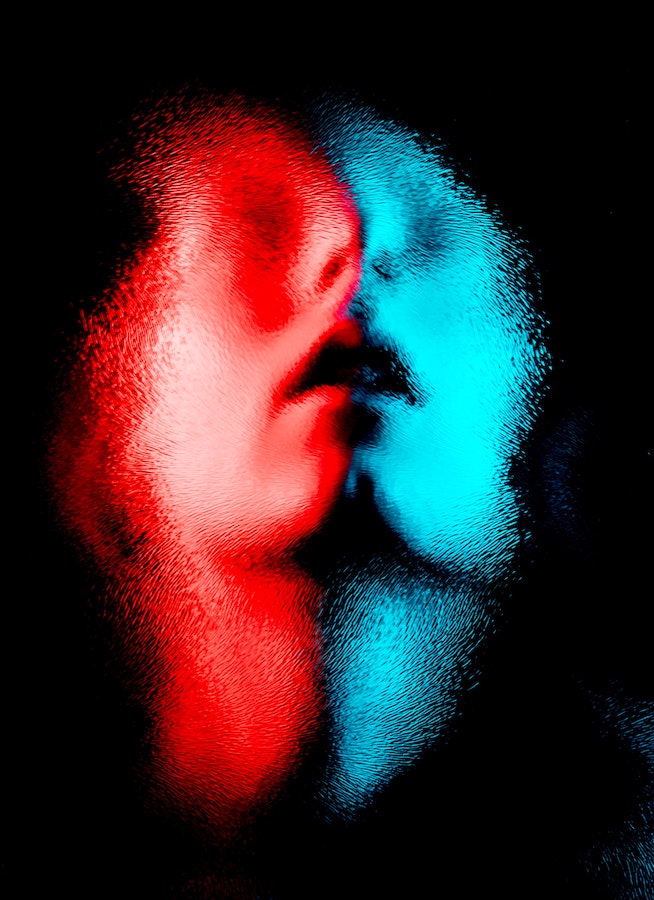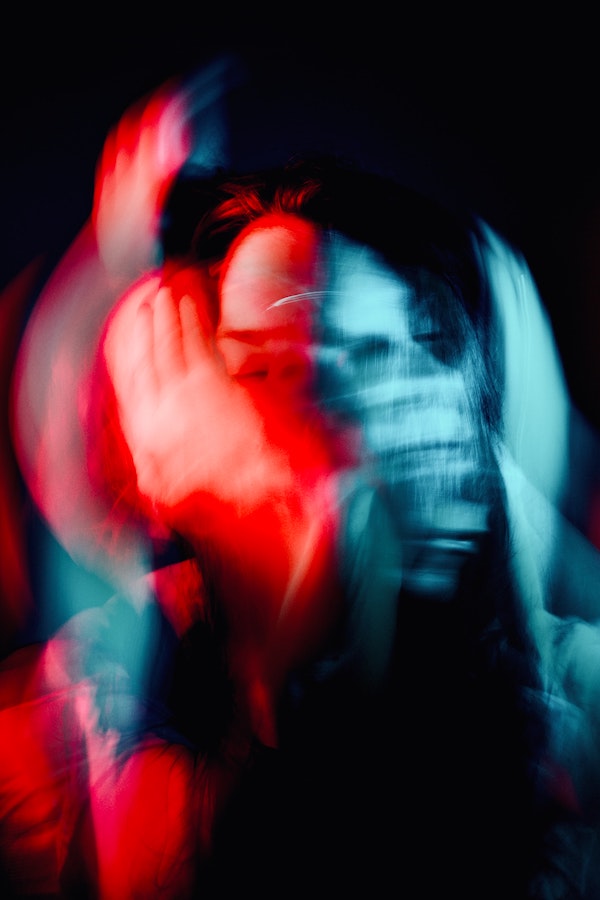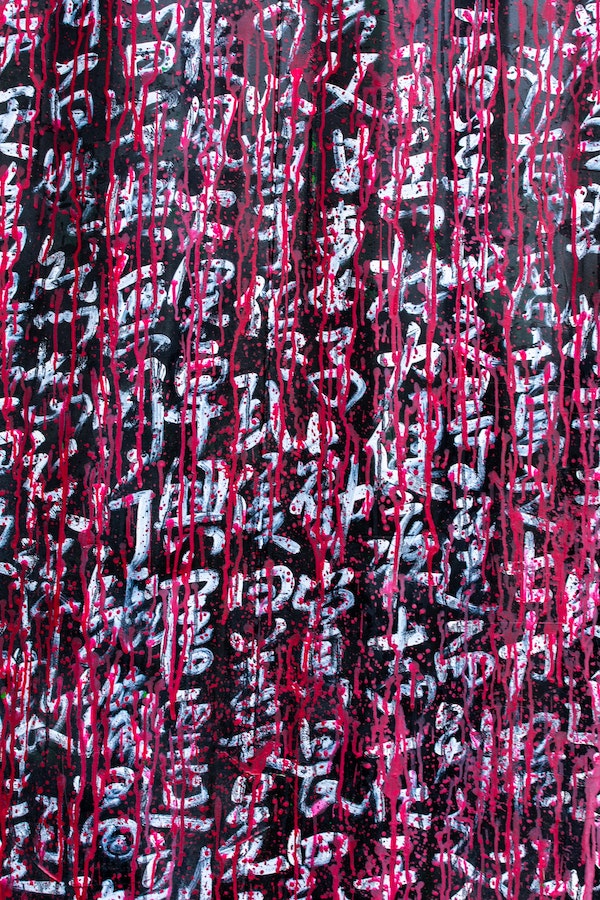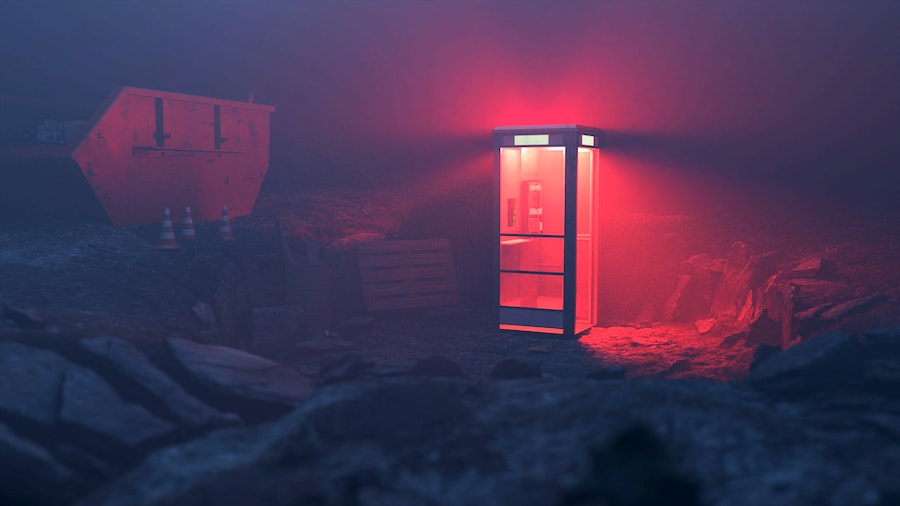Desperately Seeking Ketamine No Longer

“The music hits me, while on ketamine, in ways I cannot predict, nor handle in the moment. Sometimes, for me, any input at all, and perhaps especially music, is too powerful a stimulus. Bach just blows me away with emotion. One of my Ketamine Epiphanies of The Day is that the drug induces a state of consciousness that one’s (my, at least) ego, the construct-I-call-my-self, cannot wrangle. The I-That-I-Have-Come-To-Think-Of-as-My-Self is overwhelmed and eventually knocked sideways. Over the course of the hour I was away, eventually, my identity was marginalized; then, simply erased. I experience this, in the moment, as a hostile takeover.”—Elizabeth Boleman-Herring
Hapax Legomenon
By Elizabeth Boleman-Herring

Author’s Note: It will be useful, if you are new to my writing and if you have come to this essay seeking information about my own course (with “depression,” and with ketamine infusions as a possible therapy) to read the excerpts from my long-form writing listed, in order of publication, at the foot of this essay.
(For Dr. J., with Velleities & Fond Regrets)
The Nail-So-Not-a-Nail Rejects Further Hammering
PENDLETON South Carolina—(Hubris)—1 May 2023—Given my time (floruit 1951- c. 2031), place, and patent oddity, I, along with the hammers in my vicinity, naturally took myself to be a nail. Yes, I was clearly a nail! And I required their hammering.
A bad sleeper from birth, and prone to melancholy, panic, nightmares, and an uncanny ability to talk about all of the above from childhood on, I waited over a decade “for ketamine,” which I thought might be, for me, a silver bullet, the hammer of hammers. I kept up with data regarding the drug (two drugs, in fact, ketamine and esketamine) over the years, and hoped I’d be among those served, if not saved by it. Eventually.
But when I finally found a (knowledgeable, empathetic, generous) practitioner nearby offering infusions, not only was ketamine for me not anything like a cure, it brought me, for the duration of five infusions, administered over the course of ten days, existential terrors formerly confined to my nightmares, as well as lasting, persistent tinnitus.
I know, and trust, that ketamine infusions and esketamine (as Spravato) have performed as full or partial “reboots” for the preponderance of patients seeking these therapies.
My own experience, therefore, must be approached as anecdotal but, as I’ve spent a lifetime in the trenches of nails-amongst-the-hammers, I fear my experience must, and should, stand as a warning.
Almost nothing I have read, even anecdotally, deals with subjects such as I who, upon receiving infusions carefully calibrated to our weight then . . . journey off into hell.
Only after my infusions did I read Stephen Petrow’s Washington Post column about his own course with ketamine. Petrow, a fellow nail roughly my age, with roughly my history of mid-20th-to-early-21st-century hammering by psychotherapy and psychopharmacology, writes this:
“I saw myself strapped to a rocket shooting up into space—again, a deep black space. I very quickly lost track of time, but I also lost almost all sensation in my mouth, a result of ketamine’s analgesic and anesthetic properties. I couldn’t feel my lips and began tapping on my face in search of them. No luck. Panic. Suddenly, my throat disappeared—no feeling when I swallowed. I could only ‘see’ a black hole where it had been. I tried not to swallow, fearful that I’d choke to death on my own saliva. More panic. According to the psychiatrist’s notes I asked out loud, ‘Am I okay?” (In my head I recall shouting something more like, ‘GET ME OUT OF HERE!’) I soon felt completely immobilized, trapped in my body. I started to recall a magazine story I’d written a long time ago about a woman who lived in what’s known as a ‘locked-in” state. (According to the Cleveland Clinic, people with locked-in syndrome ‘have total paralysis but still have consciousness and their normal cognitive abilities.’) I saw myself in a glass coffin looking out into the dark universe, although I’d see flashes of deeply hued magenta and chartreuse from time to time. The doctor’s notes say I reached out to him with my left hand, a manifestation of my distress. I felt him clasp it. ‘This is my lifeline,” I thought to myself, holding on to his hand for about 15 minutes as I tried to use Morse code to communicate ‘SOS.’ (Alas, I don’t know Morse code so I’m not sure what I communicated.)”
After a friend emailed me Petrow’s piece, I watched Anderson Cooper’s “60 Minutes” segment on the use of psychedelics to treat depression, during which Johns Hopkins Professor of Psychiatry and Behavioral Science Roland Griffiths states, “We tell people that their experiences may vary from very positive to transcendent and lovely to literally hell realm experiences.”
According to reputable studies, ketamine can be life-changing for a significant majority—as much as three-quarters—of those who take it for depression. That leaves 25 percent, such as I, who have hell realm experiences via ketamine, and come out . . . still nails. But with some additional serious dents. (Note Well: I have waited over a month to write up my responses, immediate and lasting, to five ketamine infusions. I wanted to be as certain as I could be that no positive, lasting effects might later surface: they have not, and I have instead returned to better-known hammers dispensed by my primary care physician.)
A “cure” for depression and anxiety has, for me, proven as elusive as Godot. And ketamine, my latest and perhaps last hope for one has failed me. I’m here to tell you about it, in detail, hoping that what I have learned about myself and this drug may enable others to make better informed decisions about receiving it.
If you were born in the middle of the last century and began, a decade into the 21st, to own the descriptor “neuroatypical,” or even “neurodivergent” (though I still prefer “mad”), you may also have taken on board, and then, half a century later, rejected the notion that there are, might be, even ought to be a “cure” (or “cures”) for my and your alphabet diagnosis of “maladies” (Unipolar Depression + Anxiety Disorder + OCD + PTSAD + ADD).
As I grew older, and then much older, and presumably wiser, I came to look in the teeth the gift horse of diagnosis for various varieties of “mental illness” (if not for most illnesses). I began to isolate in quotation marks the diagnostic terms; to question diagnoses as they pertain to neurodiversity in general.
Over the course of a life lived with sadness, grief, and fear—sadness at what I saw happening around me; grief at what I, we all, are losing; fear of what comes next—I finally began to say, to myself and others, “in a world where our planet is dying, where constant war is the norm, and where religion and economics and government and culture have obviously become four distinct apocalyptic horsemen . . . is not sadness the most appropriate, the least mad response?
Is this nail not a nail after all?
In 2014, after entrusting my health care to Dr. Alicia Skarimbas, in Englewood, New Jersey, I wrote:
“Where I imagined, and was informed, repeatedly (primarily by old, white men, I hasten to add), that something was ‘wrong’ with me, that something needed fixing, it would have been far more useful, far more helpful, to be told what I have finally been told by my young (incidentally female) GP: ‘You are an astonishingly creative individual, with ebbing and flowing tides of inspiration and emotional expressiveness. In this wretched environment [as opposed to Greece, a country and culture my physician knows well], you are the equivalent of an Irish setter confined to a tiny cage. You have been as you are now from birth, and what you are is not covered—nor should be—by any edition of The Diagnostic and Statistical Manual of Mental Disorders (DSM).’”
As an admittedly privileged mid-centurian who has rarely, over the course of 70 years been cold, hungry, or un-housed, my history of gloom, angst, terror, paranoia, and insomnia will surely raise little sympathy among less privileged readers.
My precious time—vertical and incarnate—on our shared planet is winding down rapidly. But, still, I hope to break just a bit of ground, shed a beam of light. Attenuated Baby Boomers now “matter” only in terms of the services we render others.
The generations following me still need—perhaps need more and more—better approaches to despair.

My Ketamine Field Notes (Composed in Real Time)
February 2, 2023 (A Day After Infusion #1, 35mg)
I experienced my first infusion of ketamine as an existential assault, the single most terrifying experience of my life, to date. (The 1960s term for what followed on, once the needle in my hand began feeding the drug, would have been “a bad trip,” but, having had only the slightest brush with “bad” opiated hash c. 1971, and a very brief hallucination as a result, I had no other scary experiences of psychedelics with which to compare ketamine.
In a perfect world free of any possibility of addiction, cocaine would be my chosen, daily drug of choice. Compared to ketamine, it fuels simply a glorious, non-productive high, and I’ve only “done” pharmaceutical-grade cocaine once, in Paris, in c. 1976. My inner Presbyterian counseled sternly, “Enough!”
Yesterday, what I perceived to be happening—and I was in a state of abject terror for pretty much the entire 45 minutes—was the annihilation of my “self,” my ego, my identity, via prolonged vivisection. It was a near-death experience, but, really, more a near-death-of-the-entity-I-call-Elizabeth experience.
For as long as it went on, I was convinced I would never come out of it. I thought I would be lost in those echoing chambers of “unreality” for the rest of all time, my “ego” reduced to a tiny pinprick of its former self, cowering in a vast, menacing void, like an insect in a mausoleum designed along the lines of Fonthill Abbey.
Time and space lost their familiar contours. I looked to my trusted “guides” and “keepers”—Robin White, who sat beside me, often giving me her hand, and Dr. J., who was monitoring my vital signs from down the hall—for assurance (though it did not “suffice”) that this was a temporary flight, if with a dead stick landing. To me, for the duration, it felt like a “locked-in syndrome” that would last forever. I thought I was screaming, “Help me,” but have been assured by Robin that I was only whispering.
My tongue, at times, felt enormous and paralyzed. Unable to determine my “relationship” to my hands and feet or to speak, I took to spelling things out on Robin’s palm: “Help. Stop.” I felt I was dying and needed to say good-bye, among other things. All sense of agency left me. I reasoned with myself, trying simply to accept what I felt without judgment, to proceed on trust, but I wasn’t up to the task. Panic ensued, though it was the panic of someone in pseudo-coma.
Today, I woke not in the same trough of depression as yesterday morning, though still labile; and with a terrific headache. I hope today’s infusion experience is not a repeat of yesterday’s. But, having waited so long for “a cure,” I am trying mightily to suspend my disbelief.

February 3, 2023 (The Day after Infusion #2, 40mg)
Yesterday’s session was much less traumatic. I felt—as I recall—that three levels of self (though I could not better describe or define them) “came to bear” on the proceedings, once the drug took effect. I was aware, throughout, that I was “on ketamine.” My interior dialogue continued, as on Earth 1, meaning that my individual consciousness was more present, if still crowded out by the psychedelic. The experience was less like being ravished-against-one’s-will, and more like a roller-coaster ride which, throughout, I realized I had signed on for. The roller-coaster, on Day 2, was at least a known unknown.
My experiences, on ketamine, and exposed to music through headphones (above all other stimuli), were “synesthetic”: I perceived notes of music as words, or vice versa, and said (to myself), in real time, “So, this is synesthesia,” for me, a completely novel experience.
In addition, during both infusions, I saw very low-light and complex visual hallucinations of complex abstract patterns (similar to very complexly woven Persian carpets), in blood-red and deep-royal-blue on a black field (words cannot do these images justice). This dichotomy of color, red and blue, held for both initial infusions, though, in the late stage of Infusion 2, the colors changed briefly to turquoise and yellow. I now understand these hallucinations to be phosphenes, but “science” can’t communicate their wonder or novelty.
Upon emergence, I recalled my first memory from infancy, a dream: dark and light “forces” clashing on a visual field. Dichotomies, I hazard, are hardwired into the Homo sapiens brain: we distinguish dark only if we perceive light.
Going under, I tried to drag along with me notions of safety and hope. As the drug took hold, I repeated (silently) the words “My Beloved People” (summoning protection, after a fashion) and “No Fear.” “No Fear” I then felt to be a negatively charged mantra, so I edited it to “Peace,” or, in Greek, ηρέμησηη. I actually smiled, once, during Infusion 2, trying to tell Robin that along with the terror of abnegation the experience had, at last, brought me some pleasure.
Today, the day after Infusion 2, I am very tired, very hungover, and spacey—cognitively impaired. I feel I could sleep for a very long time, and I may do just that.
February 6, 2023
Woke throughout the night. Immensely irritable and angry this morning. Perhaps worse—for me and all around me—is being depressed and enraged.

February 7, 2023 (The Day after Infusion #3 50mg)
Woke throughout the night and, for good at 5:45 a.m. A little hypomanic yesterday, just after the 3rd infusion, and a bit scattered today, but still much brighter and calmer as per mood. A sea change since yesterday and the day before.
During yesterday’s infusion, I again experienced a lot of “background noise/voices” “behind” the music-through-the-headphones, perhaps other patients and staff speaking in the office where the infusions tke place. This should not, perhaps, have been so disturbing, but it was. (All, all that one encounters during an infusion pertains, and background noise in the therapeutic setting can be perceived by the hallucinating mind as a fearsome disruption.)
I’ve been remiss in not vetting my musical Playlist ahead of time, but I was able to tell Robin to take off the headphones yesterday after selections by Satie and Strauss. I do take my inherent fussiness, irritability, and perfectionism along with me, as unchecked baggage, “into” the universe that is ketamine. Dr. J. feels music, and headphones blocking extraneous sound(s) are crucial to the experience of ketamine. I would say further that no music is “up” to serving as an appropriate “soundtrack” for the experience, at least no recorded-in-the-West music I have used during my sessions. (This is a whole other rabbit hole of discourse, though, but suffice it to say that on ketamine, were I compelled to listen to pop or Country & Western, I would ask to be fully anesthetized on the spot.)
I recall, yesterday, wanting to tell Robin and Dr. J. that we have so, so many untapped and other “senses” besides the five we “own” as human beings. Profound waves of gratitude, humility, and remorse (though not sad remorse: simply a surge of repentance and atonement) washed over me yesterday. For about the first 40 minutes, I hesitantly embraced the experience, focusing on the words “Trust,” “Flow,” and “Safe,” though I feel like some victim of New-Age-Self-Help-dom reporting this here. But, when one is strapped into a roller coaster, and one is a tiny child—and I regress to that state during an infusion—trusting and going with the flow comprise a . . . challenge.
During Infusion 3, I told myself, when I began to be fearful: “Just ride the bull.”
February 8, 2023 (Two Days after Infusion #3)
I think the term for what I’m experiencing today is hypomania, an agitated and mixed state of it. Irritable. Cannot sleep through the night but wake and plunge into the day. It’s not depression but, equally, it’s not a state I enjoy. Caffeinated. Way too caffeinated.

February 9, 2023 (4th Infusion Today, at 3:00 p.m. 60mg)
Today, I tried the playlist Robin and I worked on yesterday, and new sound-canceling earphones: about three quarters of the way through the session, though, I again had to ask Robin to remove the headphones. Because I vetted and chose the musical selections, myself, I had imagined—at least on Earth 1, that I’d “respond well” to the music. But, as I said, coming out of the drug this evening: “No playlist is appropriate for a meeting with God.” (On the drive over from Pendleton, Robin had said: “God is not a boy’s name.” Perhaps that stuck with me, going in/under.)
So . . . the music “hits” me, while on ketamine, in ways I cannot predict, nor “handle” in the moment. Sometimes, for me, any input at all, and perhaps especially music, is too powerful a stimulus. Bach just blows me away with emotion.
One of my Ketamine Epiphanies of The Day is that the drug induces a state of consciousness that one’s (my, at least) ego, the construct-I-call-my-self, cannot wrangle. The I-That-I-Have-Come-To-Think-Of-as-My-Self is overwhelmed and eventually “knocked sideways.” Over the course of the hour I was “away,” eventually, my identity was marginalized; then, simply erased.
I experience this, in the moment, as a hostile takeover. With all that I can muster of my reduced identity, I summon Robin, that Beatrice to my infernal Dante, and beg her: “Help.” I have no real notion of when, in Earth 1 Time, this terror sets in, nor when I am able to whisper my fear. When the headphones come off, I’m a little “easier,” but not much: I’m simply awaiting the return of a universe where I have mastered some of the rules of engagement.
When not sidelined, entirely, during the infusion, I experienced very-low-light visual hallucinations of patterned, and deep red/blue grounds; then green/yellow; or turquoise/yellow, and synesthesia, wherein words morph into notes: this is almost impossible to express in language. I have intentional words, going in, which I clutch like tiny talismans: “Love,” “Heal,” “Beauty,” “Joy,” “People I Love.” But the drug asks that I give up even those anchors to reality. Finally, today, I was left with one word: “Yes.” (As per Dag Hammarskjöld: “I don’t know Who—or what—put the question, I don’t know when it was put. I don’t even remember answering. But at some moment I did answer Yes to Someone—or Something—and from that hour I was certain that existence is meaningful and that, therefore, my life, in self-surrender, had a goal.”)
I also “realized,” today, that any intentions are, for me, like tiny Japanese fans . . . held to tightly as I walk directly into . . . the hurricane that is this psychedelic.
Note well here: In retrospect, I don’t color my grudging surrender, my submission, to ketamine as either good or bad, positive or negative. But I do think my willingness to wring from even terrifying experiences some shred of the beneficial is a deeply ingrained trait of mine. Sharon Alperovitz, my most gifted therapist of the 1970s, said that, in any situation, human beings still choose, still retain the ability to choose. In however limited a fashion, we choose. And choice comprises agency, and a source of salvation. Hold that thought, please.
Another epiphany today was a feeling of abject apology as regards my high school (Francis W. Parker School of Chicago) music teacher, Chauncey L. Griffith, who rehearsed the entire school body, every four years, before performances of Handel’s “Messiah.” Mr. Griffith could never maintain order amongst his unruly, unwilling choristers, and I gossiped with classmates as the man attempted, in vain, to rehearse us. I missed out on much Mr. Griffith had to offer. (I note, upon Googling him just now, that he died at 79: eight years older than I am at present.)
After today’s infusion, I took much longer than after the three preceding infusions to recover my equilibrium. Hours later, I am still “under the influence.” Late this same night, I am quiet, and avoiding stimulation: my brain wants salt, carbohydrates, fluids, and sleep.

February 10, 2023 (Before Ketamine Infusion #5)
I woke repeatedly—yet again—before dawn; finally up at 8. Yesterday evening, I had an agitated panic attack trying to remember a piece of classical music I learned at age 14. Really, I was obsessed until I retrieved the memory. I could literally see, eidetically, the mimeographed sheet of music in my mind, but the lyric and composer would not turn up on Google. Finally, I determined that my music prof had set a Parry poem to a Bach tune . . . himself, and then mimeographed the piece for 500 students to sing.
Ketamine has compelled me to consider, deeply, the nature of human memory; how it is “laid down” in the first place; how it is retrieved, buried, and/or lost.
My initial utterances, coming out of the drug yesterday were responses to my new (mainly Bach) playlist (and God). When I could once again use my lips and speak, I exclaimed: “Holy Magillicuddy!” Have I ever before actually said, “Holy Magillicuddy!” And where did/does that come from?
The terror and the beauty of ketamine’s visions is unnerving. I don’t know how I find the courage “to go back in.”
February 10, 2023 (After Infusion #5 60mg)
On the way home, I was finally able to articulate to Robin one of my two primal fears while on the drug: 1) I am going to swallow my tongue; and 2) I am not actually going to die, but I am going forever to be suspended in a dissociated, “embryonic” state—neither fully unconscious nor fully embodied—bounced around like a tiny, minimally-sentient insect in a void of unearthly experiences.
On ketamine, I think I actually enter into (or, better, perceive myself to have entered into) what some call The Bardo. As per Wikipedia:
“Used without qualification, ‘bardo’ is the state of existence intermediate between two lives on earth. According to Tibetan tradition, after death and before one’s next birth, when one’s consciousness is not connected with a physical body, one experiences a variety of phenomena. These usually follow a particular sequence of degeneration from, just after death, the clearest experiences of reality of which one is spiritually capable, and then proceeding to terrifying hallucinations that arise from the impulses of one’s previous unskillful actions. For prepared and appropriately trained individuals, the bardo offers a state of great opportunity for liberation, since transcendental insight may arise with the direct experience of reality; for others, it can become a place of danger as the karmically created hallucinations can impel one into a less than desirable rebirth.”
At about 37 minutes into today’s session, I asked Robin to end it: I was simply too existentially frightened to proceed. I was not a “prepared and appropriately trained” individual.
Epiphanies today: 1) It’s better to do ketamine with an unfamiliar if trustworthy Playlist, as the Bach pieces I have chosen, heretofore, come too freighted with emotion for me; 2) I cannot emphasize enough that, once truly under, a patient MUST have someone “on hand,” literally, to comfort and advocate. Bad trips are a real possibility, and you want to be able to issue a Mayday, and have it heard/acted upon with speed.
Note: One of my first “introductions” to ketamine and its possible use for those seeking an end run around melancholy, came about 15 years ago when I read about Marcia Moore and Dr. Howard Altounian’s experiences with the drug. Their book, Journeys Into the Bright World, was unavailable to me at the time, but I include a pdf in the Further Reading section following this essay.
It is theorized by researchers that Moore died of exposure after a massive self-delivered dose of ketamine, which she had begun using daily as a means of accelerating what we would now term spiritual growth.
I have known since I first began seeking the drug in a controlled, therapeutic setting that ketamine is a formidable agent in the dosages that effect dissociative experiences.
In Dr. J.’s carefully curated, peaceful, safe clinic, and under his empathetic, science-informed care, I knew I would receive the best imaginable experience of the drug . . . even if it failed to be, for me, therapeutic.
I approached the experience willingly, if with appropriate trepidation, but longtime users of psychedelics all know something I did not: psilocybin, ketamine, LSD, and other psychedelic substances are, by definition, “black box drugs,” worthy of respect, and not to be taken on a lark, because they pack an existential wallop . . . and I , among others, am not up to such a wallop.

February 11, 2023 (Day after Infusion #5 60mg)
Could not fall asleep, despite (my usual doses of) Ambien and Hydrochlorothiazide HCL, taken at 9. Awake, reading-w/o-retaining-anything till midnight. Nightmares which I could not remember upon waking, but not my usual variety of nightmares, which are hair-curling.
My executive functioning is not up to speed today: I’m scattered—as though my ADD has shifted into a new gear well beyond 5 or 6. Leave the room intending to do something; it’s forgotten seconds later. Due to the ketamine, this drop in IQ is not interpreted with alarm, but, Damn, will I ever “come back” and be able to write/think again?
Also, woke with a massive, pan-skull headache and high-frequency tinnitus which sounds like a ten-fingered chord played on an infernal organ. What does ketamine do to intercranial pressure, if anything? (My initial, layman’s research says the jury is still out on this.)
Have taken 1 Excedrin Migraine, and pain’s receding, but the tinnitus is still omnipresent.
EPIC ADD today. Have literally lost “my” mind. Cannot multitask, let alone task. Yikes! Nightmare of a day-in-this-body: scattered thinking and actions; inability to focus, or remember, from one minute to the next; crushing migraine, which has migrated all over/within my skull, settling in my L facial/cranial (?) nerves from early evening on.
Watched, again, “The Diving Bell & The Butterfly,” the 2007 French film based on the memoir by Jean-Dominique Bauby, who experienced locked-in syndrome following a massive stroke.
While under ketamine, I called to mind the film, the syndrome, and even the film’s soundtrack: the experience of ego-dissolution, for me, is one of terror. As opposed to a near-death-experience, I have what feels to me as a having-died-experience . . . and the pain of leaving my consciousness behind, forever, invokes feelings of such horror, such sadness, such fright, such regret as to be untranslatable.
I have been largely immobile all week; overeating, and craving carbs and salt and sugar. This is not going well for me somatically!
Imagine, if you will, writing ad copy for a ketamine cruise or vacation: “Come away with me! An hour will feel like an eternity. Really! And you’ll be out of control, paralyzed in the dark, dependent on others for everything, and scared shitless. And then, you’ll simply stuff yourself with junk food and go home with a migraine, unable to write or even speak intelligently (which, let’s face it, is all you had left).”
Would you buy a ticket?

Sunday, February 12 (Two Days after Infusion #5 60mg)
I woke at 6, startled back into consciousness, with L-temple migraine, mental scatteredness, and high-pitched tinnitus. And depression; hopelessness. So . . . now I have my old familiar, Despair PLUS the new bedfellows of mental defect, headache, and tinnitus.
How is this a good thing?
From Wikipedia (and I waited to research the bad effects of ketamine till now, as I wanted to avoid auto-suggestion):
“Whereas the common recreational dose of ketamine is roughly 30–75 mg, a dose of more than 150 mg is required to enter the k-hole. The k-hole, or ‘k-holing,’ can produce intense psychological effects, such as hallucinations, and physical effects, such as uncoordinated movement or dizziness. Often likened to a ‘near-death’ experience, entering the k-hole can inhibit movement and speech, and even produce paranoia and violent agitation. . . . . While many ketamine-users may find the dissociative effects of falling into a k-hole to be pleasurable, coming out of this state of dissociation turns out to be rather difficult. As a result, individuals find themselves in an ongoing state of disconnection from the world and from life. Short-term risks of ‘k-holing’ include the feeling of nausea and/or vomiting, increased heart rate, and elevated blood pressure, as well as the loss of coordination. Frequent k-hole experiences can also result in episodic and semantic memory impairments. Depending on how long this state lasts, hallucinations and symptoms of psychosis can develop. The k-hole experience can produce physical risks. For instance, bladder damage can be an indication of ketamine-induced (ulcerative) interstitial cystitis. Cardiac issues and seizures belong to the long-term effects as well.”
From Mel Magazine (admittedly, not a peer-reviewed source) this:
“A K-hole is an experience that occurs when you take enough ketamine to induce psychosis. When this happens, the thalamic reticular nucleus located near the center of the brain ‘stops functioning properly and leads to an excess of dopamine released,’ explains physician Lawrence Weinstein, chief medical officer of American Addiction Centers. ‘The excess dopamine released due to thalamic dysfunction also causes dopamine to reach the prefrontal cortex, which is an area of the brain responsible for reasoning and decision-making, and the striatum, or the reward center.’ … Alison Draisin, a psychotherapist and psychologist who provides ketamine-assisted therapy, agrees, equating a K-hole to an ego death. ‘From a clinical perspective, the K-hole is where ego dissolution occurs,’ Draisin explains. ‘When you’re in it, there’s no getting out of it—not with a song, not with an elixir, not with anything else. You just have to ride it out.’”
I think that, given the unique nature of my psyche, I needed more preparation for this therapy. From Mindbloom: “After a k-hole, it may be difficult for an individual to release the feeling of dissociation. They may continue to feel disconnected from themselves, the world, and the meaning of their lives. Excessive ketamine use can also cause hallucinogen-persisting perception disorder (HPPD) in some individuals.”
I feel as though—I persist in feeling as though—I am a burden to those around me; that I take up all the air, all the energy in any room; that I wear out my loved ones.
I have tried this therapy, and I have failed/it has failed me. I did not come to it asking for further challenges, further impairment, but here I am now.

At 2 p.m., over 48 hours after Infusion #5, I am now beginning to feel more myself. I’ve spent most of today in a fetal curl, weeping. I had editing to do, but I was incapable of summoning up the vocabulary and syntax needed for these tasks, and they will just now have to wait . . . which would be OK, if these failures did not involve disruption (I’ve just struggled to retrieve that word) of cerebration. And, heretofore, I’ve had no certain, secure, steady pillar in life but my ability to reason.
My NP here in Clemson posits that I am a “slow metabolizer,” and I would like to discuss this further with Dr. J. when he has time. For me, large doses of some medications seem ineffective, but appropriate doses of other meds (most notably, and horrifically, steroids) overwhelm me. My response to Dilaudid, following spinal surgery, was a case in point: I experienced wild, terrifying hallucinations, and attempted handstands in my hospital room. I had a Russian night nurse who was on her phone in the hall for a spell only to come back and find me upside down in the middle of the room.
Might my response to “seemingly appropriate-for-me doses” of ketamine reflect an idiosyncratic metabolism of the drug? Or be a response influenced by my years-long dependence on Ambien for sleep?
I feel so, so, so impaired.
The tinnitus, too—a high, loud, relentless chord—is unflagging, as is the L-temple migraine. Verbal skills still impaired. Less anxiety; more resignation.
I found, in my reading of scientific abstracts today (as opposed to anecdotal civilian reactions) a study of sheep-on-ketamine. My first thought was, “Sheep on ketamine? How is this a thing?” But, of course, “we” test everything on our unsuspecting, non-Homo-sapiens brethren.
“Ketamine is a valuable anaesthetic and analgesic that in recent years has gained notoriety as a recreational drug. Recently, ketamine has also been proposed as a novel treatment for depression and post-traumatic stress disorder. Beyond its anaesthetic actions, however, the effects of ketamine on brain activity have rarely been probed. Here we examined the cortical electroencephalography (EEG) response to ketamine of 12 sheep. Following ketamine administration, EEG changes were immediate and widespread, affecting the full extent of the EEG frequency spectrum measured (0–125 Hz). After recovery from sedation during which low frequency activity dominated, the EEG was characterised by short periods (2–3 s) of alternating low (<14 Hz) and high (>35 Hz) frequency oscillation. This alternating EEG rhythm phase is likely to underlie the dissociative actions of ketamine, since it is during this phase that ketamine users report hallucinations. At the highest intravenous dose used (24 mg/kg), in 5/6 sheep we observed a novel effect of ketamine, namely the complete cessation of cortical EEG activity. This persisted for up to several minutes, after which cortical activity resumed. This phenomenon is likely to explain the ‘k-hole’, a state of oblivion likened to a near death experience that is keenly sought by ketamine abusers.”
The bolding and underlining above are my own.
Monday, February 13 (Three Days after Infusion #5 60mg)
Of note, perhaps: “The Antidepressant Effect of Ketamine Is Dampened by Concomitant Benzodiazepine Medication, which states, in part: “To conclude, our study indicates that concomitant BZD treatment attenuates ketamine’s antidepressant effect. This fact should be considered in the clinical management of ketamine treatment and future research design.”
Last night was, perhaps, the worst night—vis-à-vis depression, anxiety, and somatic distress—that I have had since Xmas, with fierce, L-temple migraine, and deafening, high-frequency tinnitus.
This morning, the headache has lifted and the tinnitus, while still there, has receded about 50 percent, I would say.
Spoke with Dr. J. at some length, and have learned that mine is, for him, a novel reaction to the dosage(s) I have received.
We have determined to do nothing more for two weeks.

Summing Up
And so I end, with an informed whimper as opposed to a bang.
As of March 18, 2023, a month out from my five infusions (I declined a sixth, though six infusions, based on weight, comprise the standard course), my headache has lifted and I have turned, once again, to the hammers my Nurse Practitioner is able to wield: Quietiapine Fumerate, Ambien, Adderall (when writing), and Hydroxyzine HCL.
My tinnitus remains, and it comprises torment. Perhaps it will lift; perhaps it’s just part and parcel of the risk I willingly took, the price of doing business, along with the steep-for-me, out-of-pocket fee for five infusions.
A few days after my last infusion, a scene near the end of Miloš Forman’s film about comic, performance artist, and magician Andy Kaufman, Man on The Moon, floated into my consciousness.
Kaufman, dying of large cell carcinoma, visits a “psychic surgeon” in the Philippines, and undergoes “surgery” to remove his tumors. On the operating table, Kaufman—one savvy con-man observing another—sees that the “tumor removal” is in reality a sleight-of-hand con perpetrated by “medical magician” Jun Labo. Jim Carrey, as Kaufman, conjures a world of emotions in his silent, expressive face: he knows he’s dying; he knows Labo is a fraud; and yet he has a grudging respect for another master of the art of deception.
I am not saying I have been deceived regarding the benefits of ketamine infusions for what ails me, for what persists in ailing me. But perhaps I have deceived myself as regards my diagnosis and the possibility, at this time, of treatment.
The enormously qualified physician who offered me a course of ketamine has done everything in his power to create an oasis of calm in which to receive the drug. I would say that Dr. J. “approaches the shamanic” in terms of his palette of gifts and skills.
My conclusions about the success of my treatment, thus far, however, are bleak, if equivocal.
I’m not sure that, even if I had known, going in, how fearful an experience I might have, I would have made the decision not to give ketamine a shot, at least one shot, though not five.
As a result of my journeys into the dark world of ketamine, I have experienced visual and existential wonders not approachable, I believe, by other means. I have stepped outside the confines of my mind-as-I-knew-it, to consider varieties of experience hitherto denied me.
Would I have spent the $1,500. on a ticket to Athens, Greece rather than five trips down the k-hole?
Would I have taken the infusions, knowing that tinnitus—seemingly here for good, now—would be a side effect?
Dear Dr. J., I believe that, knowing everything I know today, I would do it again . . . once. One infusion. and that, only with you and Robin on board.
I believed you when you read me the stats and told me about your own patients’ success. I still believe you, and I know that those who entrust you with their care are in good hands.
But some of us nails are much more complicated than we appear, and our grey matter, though old and exceedingly gnarly, is infinitely precious to us.
So . . . hammer carefully, if at all, at some of us.
And keep my tale in mind, going forward. For if I know one thing for certain about myself, it is that I may be neurodivergent, but I am not at all unique. Others will come to you seeking relief, and experience . . . further damage.
![]()
Further Reading from My Essays on My Own Neurodivergence
Note: I’ve pulled excerpts to give readers the gist of each essay, the entire body of which writing comprises my anecdotal wisdom regarding (my own) neurodivergency over a 70-to-100-year-long (Reader, I am still alive) chunk of the mid-20th to the mid-21st century.
“Where I imagined, and was informed, repeatedly (primarily by old, white men, I hasten to add), that something was ‘wrong’ with me, that something needed fixing, it would have been far more useful, far more helpful, to be told what I have finally been told by my young (incidentally female) GP: ‘You are an astonishingly creative individual, with ebbing and flowing tides of inspiration and emotional expressiveness. In this wretched environment [as opposed to Greece, a country and culture my physician knows well], you are the equivalent of an Irish setter confined to a tiny cage. You have been as you are now from birth, and what you are is not covered—nor should be—by any edition of The Diagnostic and Statistical Manual of Mental Disorders (DSM).’”
“I raise my eyes now and look at Sally’s work before me. To me, this painting ranks with the works of Mozart, Byron, Van Gogh, Picasso. Sally’s signature style never wavered. The brush strokes are sure and certain. The ‘holy figures,’ the muses, whom she felt surrounded her are here, embodied. Plato said, ‘If a man comes to the door of poetry untouched by the madness of the Muses, believing that technique alone will make him a good poet, he and his sane compositions never reach perfection, but are utterly eclipsed by the performances of the inspired madman.’ Sally would have liked that, had I known the quote while she still walked here, on Flatland, with me. Her paintings, like the artist who rendered them, are afire with madness, inspired by Muses. They reflect the woman who descended, briefly, among us: mad and gifted. I am so grateful to have known her, grateful to have been kept safe, by her, from her demons. Grateful to have, left of her, one sublime painting.”
“Between Dante’s ‘Nel mezzo . . .’ and ‘E quindi . . .’ lies one of the greatest journeys, and extended metaphors, in Western literature. That the Florentine poet’s Commedia is titled just that—’The Comedy’—and, later, amended by Boccacio to read ‘The Divine Comedy’—has to do with the stars the protagonist views at the end of his spiritual odyssey. However, what we remember best about the Commedia is its ‘dark wood,’ its ‘Inferno,’ which is why those who live out their lives, lost again and again and again in that dark wood, in depression, turn so naturally to Dante for words with which to describe their state. For we depressives are suspended throughout the vast, shadowy circles of hell; beneath, below and out of sight of even the Purgatorio, let alone the Paradiso and the stars beyond. Unless rescued, guided onward and upward and out, yanked off the wrong path and into the light (Dante’s “shining world”) by pharmaceuticals or the inscrutable natural cycles of ebbing and flowing neurotransmitters or, most finally, released, by our own hands, into oblivion (whether light or yet more dark, we cannot know from this plane), we remain lost, caught in medias res, helpless.”
“Once violated, once traumatized, a young victim can never eradicate the probing fingers, and more, from within the most intimate folds of her or his flesh; her or his memory. The 60-year-old is, somehow, always 13, and the condition—mine—is now called PTSD, and I suffer from it as surely as does the returning, ‘shell-shocked’ vet. Dr. B and I are ‘married,’ one flesh, till death do us part. He saw to that. Dr. B was not always so much with me, however, at least not at the level of complete consciousness. Between the year the abuse occurred—over the course of the summer of 1964—and the year, almost 30 years later, when the toxic memories of those long-ago events finally burst back into my adult consciousness, with a rage as blue-white as a Bunsen burner’s flame, I had packed them away so deeply that they existed, for all intents and purposes, in a storage unit located outside my body; outside my mind. I had stored those memories . . . where the sun don’t shine.”
“A few weeks ago, I fired my psychoanalyst. A Freudian. Not a neo-Freudian, mind you. A Freudian. I should have known better. I gave it (the whole schtick; him; us) about six months, and then I wrote the man a “Dear John” letter and did not go back. He was angry. He said cruel things on the phone the last time we spoke, just before I hung up on him. More than a bit cowardly of me, you might say, but Freudians have way, way more firepower at their disposal than I, and this fellow had already called me, on several occasions, a ‘quitter’ (for dropping out of multiple Ph.D. programs in my salad days), and I knew further (and darker) epithets awaited if I’d just sit still for them. We weren’t a good match, Sigmund and I. In my experience, though, most Ph.D. programs were designed for one thing, and one thing only: quitting. (I’ve also ‘quit’ two gay husbands and one paranoid schizophrenic one, so I’m a multi-purpose quitter, in Sigmund’s book.) But I am not, I submit, a quitter for quitting those programs; those men. When I know, for certain, that an institution (The University of Georgia, for example; or my gay, gay husband on Mykonos), is going, without a shadow of a doubt, to suck the marrow from my bones, make my life a desert, remove the light from my eyes, I write a polite letter, and I walk. Out. Without a dime or a diploma, I walk.”
“As writer Russell Banks phrases it: ‘ . . . in my view the world is such that any other response to it than sadness and anger would be inappropriate.’ Most of the time, that’s true, Russell; most of the time. And the times of enormous joy, seemingly relentless creativity, and body-blistering passion only serve to show up the true depth of the troughs of misery, despair, boredom, ennui, and what have you in between the little peaks. The human landscape. It sucks. Big time. And my own stretch of it has truly sucked. I could list the deaths, the illnesses, the losses, the denials, the dashed dreams—the particularly sucky stuff of my particular life—but I’ve written memoirs covering most of it already. This latest descent I chalk up to Post-Partum-Ness, in that I wrote this glorious novel in under a month’s time, after wrangling it like a brahma bull in a convenience store for well over ten years. The Focalin—two tiny doses a day—made me able to sit and write for eight-hour stretches: Voila! Novel accomplished. Then came the crushing wave of grief. WHY THE F%$K HADN’T SOME EARLIER GENIUS NOTICED I HAD ADD 30 YEARS AGO?????!!!!!!! The waste. The loss. The irretrievable years.”
“My first memories feature fear. Fear, solitude, ‘unreality,’ the night, and unconsciousness. Or a type of consciousness, a species of unreality we choose to call, in the West, ‘dreaming.’ My first memories are of nightmares. My first memories are nightmares. They live on, 54, 55 years after the fact. What does it mean that I cannot, will not, forget them? I was told, so often, in infancy, in early, early childhood, about my paternal grandfather’s holding me up to look over a fence at rabbits, that, for a long time, I believed that was my first memory. Peaceful. Secure. Held aloft, and conscious. In the light. In someone’s safe arms. ‘Don’t you remember? You remember, don’t you?’ But it was not true. My first memory is of a dream that came so early I had no language for it, or in it, and there were no rabbits. I am alone, on a vast, dark plain, between two advancing armies; or two advancing forces. Multitudes which will clash just where I am standing. I know this, and flutter back and forth; first, in one direction; then, the other. The dream recurs, but always ends before the inevitable. (I woke, to dream it all again. And again and again.) In my second dream, my second memory—and I am by now a toddler in a crib—my stuffed animals, piled at the head of the bed, piled as high as the crib’s headboard, collapse on me in my sleep, and smother me. Once I know such a thing can happen, how can I sleep? Ever again? How can a toddler “imagine” her own obliteration? What force hardwired that into my still-soft head?”
“Ketamine works on depression, and on recalcitrant post-operative spinal pain—the two conditions that afflict me. In my humble opinion, that ketamine may someday be named ‘Zaramanji,’ or somesuch, in this country is indicative of at least a possible ‘conflict of interest.’ Ketamine’s been around for a long time, for on-label use as a pediatric and veterinary anesthetic. If, in his study, Dr. Zarate beats everyone to the punch in ‘proving’ ketamine’s benefit for depressives, he may well get his patent. But to patent ketamine is morally equivalent, in my little book, to ‘patenting’ acetaminophen or aspirin. Ketamine should be made available, and cheaply, to depressed patients and those suffering debilitating pain, w/o first enriching a pharmaceutical company riding along on the bent backs of . . . people such as I, a premium attached to its currently off-label use. Are you following me? There’s a thin, thin line between those who would experiment upon those who cannot really supply their ‘Informed Consent’—and I number all the long-depressed in this group—and members of my species who treat their fellow beings as less than human. I believe, with all my heart, that the taxpayer-funded N.I.H. is crossing this line today. I was given no evidence, when I was on Ward CRC-&SE North at the N.I.H. in Bethesda, that the N.I.H. cared a whit for the psychological welfare of its ketamine-study subjects. The sole stated concerns were to keep everyone as comfortable as possible for the duration of the trial. (My Consent Form baldly states: ‘There is no direct benefit to you from participating in this research study. However, we hope to learn more about mood and anxiety disorders and you will find out if you are eligible for other NIMH research studies.’ Good God, do some people spend their entire lives on these wards? Un-paid, untreated, participating in study after study?)”
“Since all pamphlets alluding to the existence of this marvel were stashed in a dark back hall of Ward 7, it’s a small miracle that I found them, and read about the NIH Labyrinth. The maze is intended to promote ‘inspirational healing of mind, body and spirit’ and, since my own clinical trial-sters had made it abundantly clear to me that they weren’t in the business of therapy, but only research, I now wonder if some agent provocateur of palliative care might have left those Labyrinth pamphlets on Ward 7 as a political statement. Since The Labyrinth is only open for use every first and third Tuesday of the month, from 8 a.m. to 10 a.m. and 1 p.m. till 3 p.m., and since it took me circa 45 minutes to navigate it, it’s a wonder anyone experiences any ‘inspirational healing’ it might provide. You have to be lucky, speedy, devious, and determined even to find the damned thing. I guess it was just my week. The week began with a Lenten service, an interdenominational Protestant affair, presided over by one of the NIH chaplains, a woman from Spain named Diana. This ebullient pastor spoke about repentance, and treated her minute flock as though we were educated, literate and skeptical—a sort of miracle in and of itself. She traced the etymology of repentance in several languages; one of them, Greek, quite close to my heart. In the Greek, metanoia, badly rendered as repentance, more properly means ‘to re-think something,’ ‘to change one’s mind’ or, as Diana phrased it, ‘to consider a U-Turn.’ If you go through the Bible and replace the verb ‘to repent’ with the more proper ‘to re-think,’ it might, for you discerning as opposed to Bible-thumping readers, lend Christianity an entirely different flavor.”
“But, if I search for a ‘cause,’ a ‘prime mover’ in my depression, it is not in the realm of events, I think; nor even, though I go right against the grain here, in biology. I was born looking death in the teeth. But the condition is not quite like diabetes (juvenile), nor childhood epilepsy—not quite. It’s not a question of brain or bones, but of mind, and our species hasn’t really got round to what to call mind, yet, though I doubt it’s a ‘thing.’ I simply feel I was born ‘knowing’: Fey, in some way. I was born old, informed, well before my time, of the existential dilemma. In on a bad secret. To carry the metaphor just a step further, I was born with two minds, of two minds, one of which repeated, over and over, to the other, and not therapeutically: ‘This, too, shall pass: and then there will be nothing.’ All losses, all deaths, all sorrows that I experienced in life were not causes of this depression, this world view, this bleak certitude, but merely served to validate it. They were evidence, proof, for a premise I latched on to at birth. In 1972, my father, an uncle, two aunts and a great aunt all died. In a year’s time. I divorced the homosexual classmate I had, unwitting, married at 19. I succumbed to an autoimmune illness and was hospitalized, crippled. But I was depressed long before these ‘events,’ these so-called ‘life experiences.’ In my case, the horse came well before the cart.”
“I was the summer’s designated sacrificial lamb, too young to understand what was being done to me; too young, and well-brought-up to fight back against an authority figure: if a doctor does it, if a man-of-the-cloth does it, if a policeman does it, can it be wrong? Children make such docile, delicious victims. They are all but unconscious, unless brought up, hard, on the street. And the street was as unknown to me as abuse of any sort. I now believe both my childhood friend and her brother were also victims of The Monster, as I came to call him, a man now long dead. I surmise this only from the rage that boiled up in me that summer; a rage mirrored in the eyes of the other children at the ranch. Perhaps, oddly, I had no idea why I was always angry there. The rage had a life of its own, and surged up and over for no apparent reason. I raged at the doctor, but had no idea why. And then, once my parents had come to collect me, and I, stutteringly, tried to tell my mother that “something” had occurred between me and Dr. B . . . I simply ‘went unconscious,’ like Sleeping Beauty, for decades and decades, till the memories welled up, at last, in adulthood, devastating in their detail.”
![]()
Further Reading
Journeys Into the Bright World: Pioneering a New Path to Higher Consciousness—A Personal Account by the Extraordinary Couple Who Risked Everything to Learn Its Secrets, by Marcia Moore and Howard Altounian, MD, Para Research Inc., Rockport, MA, 1978.
“Ketamine for depression: What it feels like and who it can help,” by Rachel Zimmerman, “Washington Post,” September 12, 2022.
“Mystery of vanished heiress: Was she murdered—or ‘dematerialized’?” by Isabel Vincent, “New York Post,” December 18, 2021.
“Psychedelics really can reshape your mind, and a new study says that might help explain some of their benefits,” by Yeji Jesse Lee, “Business Insider,” February 17, 2023.
Regarding “silver” or “magic” bullets: Silver Bullets, Wikipedia entry.

